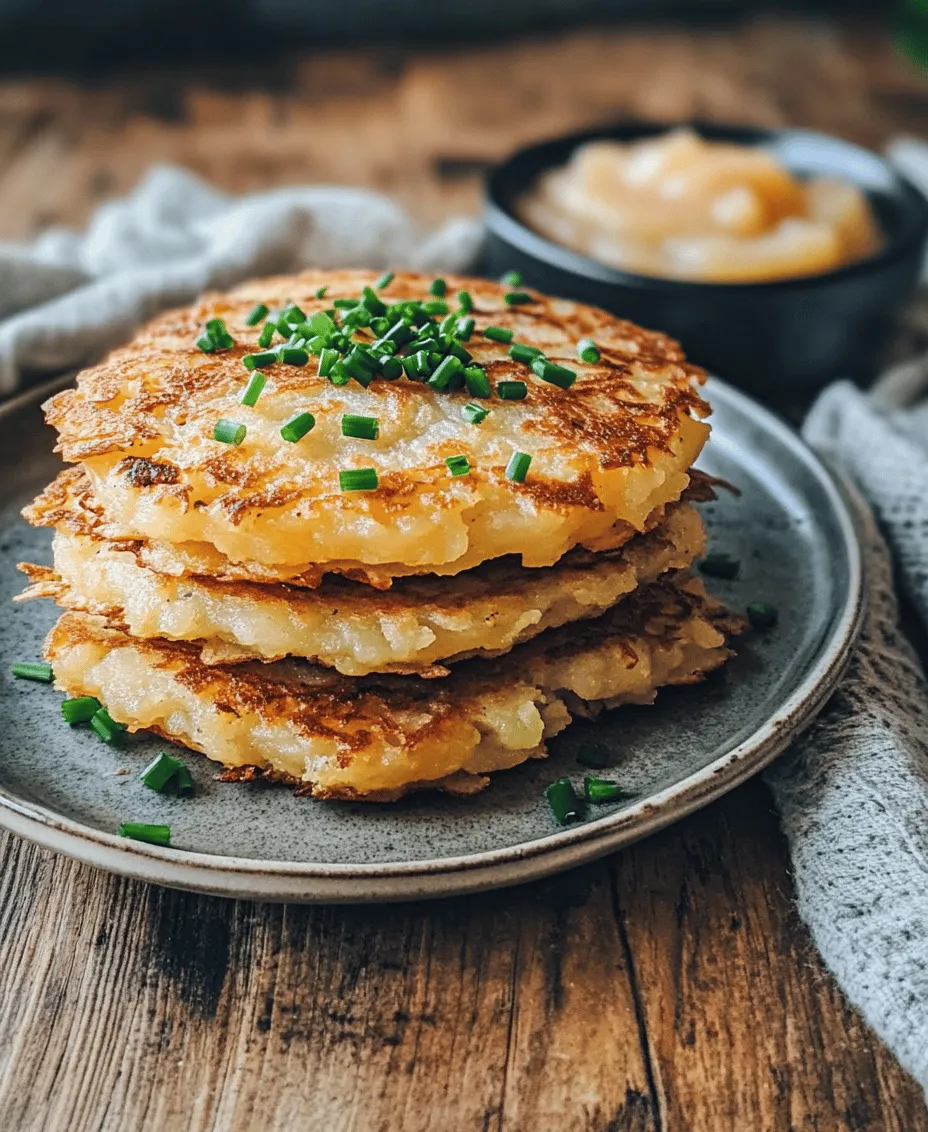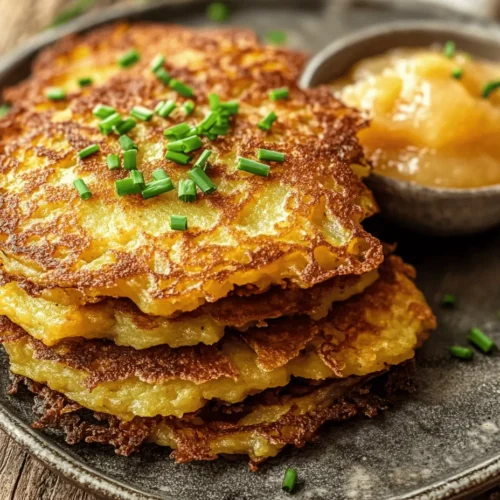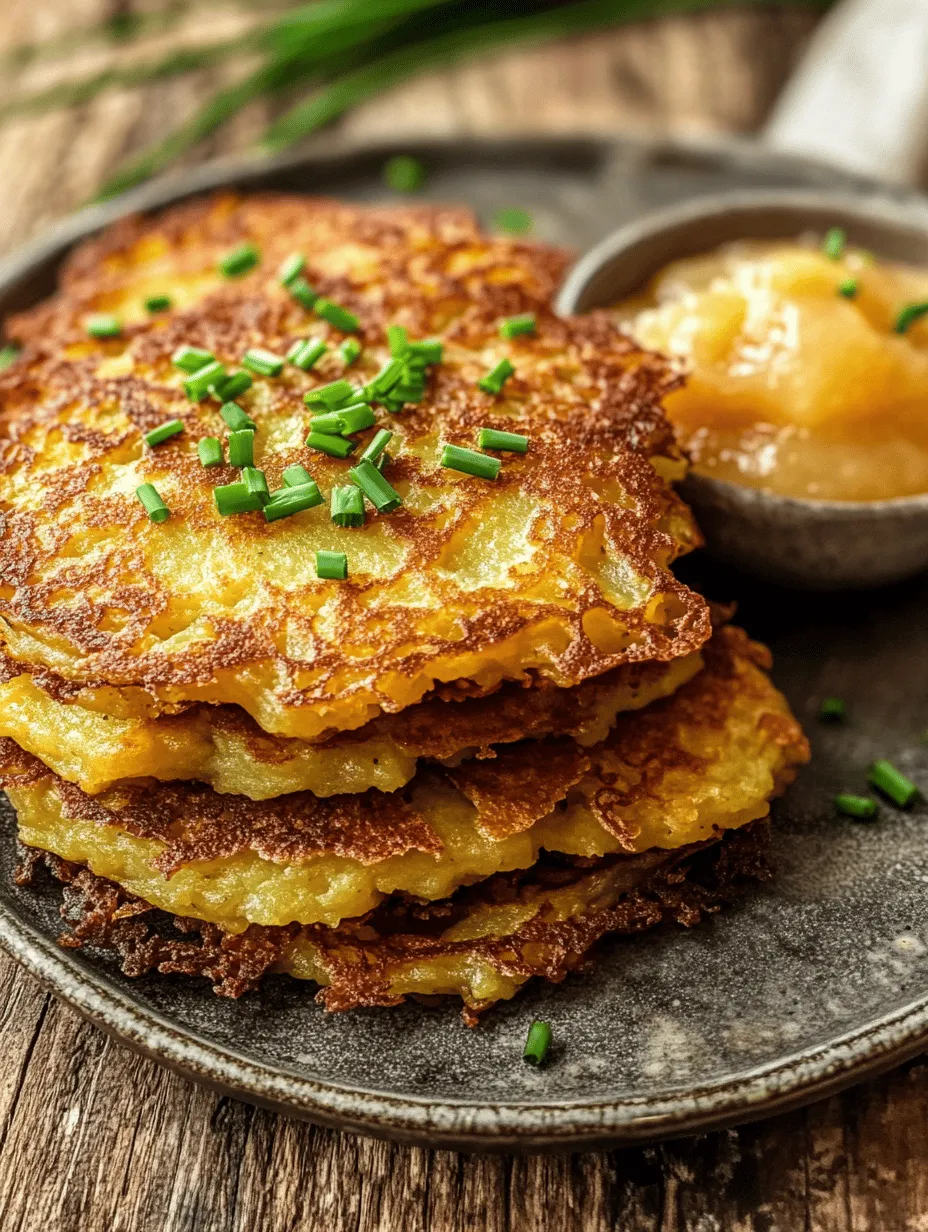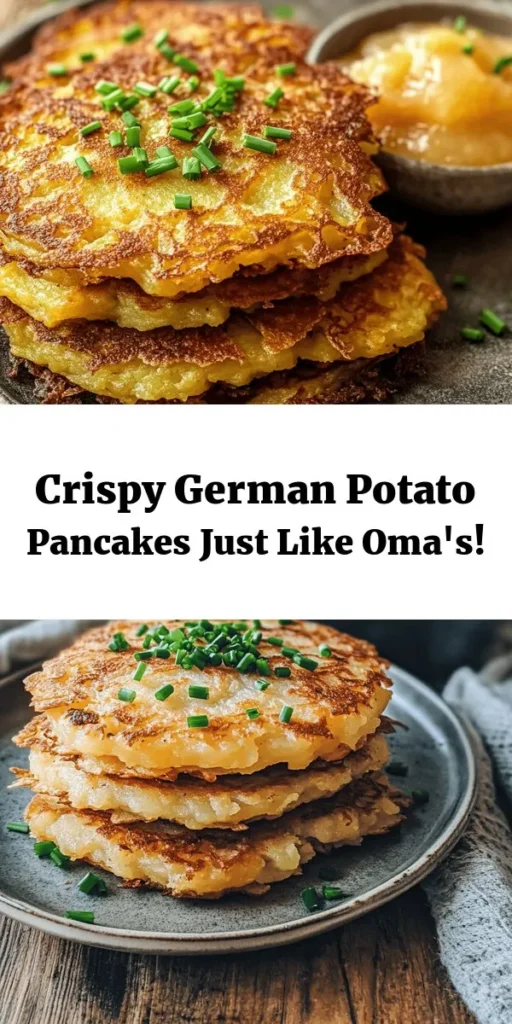Introduction
When it comes to comfort food, few dishes can rival the humble potato pancake, especially in the rich tapestry of German cuisine. Known as “Reibekuchen” or “Kartoffelpuffer,” these crispy delights are more than just a meal; they are a cultural emblem, a cherished family recipe passed down through generations. With a satisfying crunch on the outside and a tender, flavorful interior, potato pancakes embody the heart of traditional German cooking.
The history of potato pancakes is intertwined with the history of potatoes in Germany, a staple that became a household favorite after its introduction in the late 18th century. Initially met with skepticism, the potato proved to be a versatile ingredient, leading to countless variations and preparations. Today, Reibekuchen holds a special place not only in the hearts of Germans but also in the kitchens of food lovers worldwide. Whether served at festive gatherings, local fairs, or simply enjoyed at home, these pancakes are a testament to the joy of cooking and the warmth of shared meals.
In this article, we delve into the world of crispy German potato pancakes, guiding you through a straightforward recipe that highlights the beauty of this traditional dish. We will explore the essential ingredients that contribute to their unique flavor and texture, as well as provide step-by-step instructions for achieving the perfect balance of crispiness and softness. Whether you are a seasoned chef or a novice in the kitchen, you will find that making Reibekuchen is not only simple but also immensely rewarding.
Understanding the Ingredients
To create perfect crispy German potato pancakes, it’s crucial to understand the key components that contribute to their delightful taste and texture. Each ingredient plays a specific role, ensuring that the final product is nothing short of irresistible. Let’s take a closer look at what makes these potato pancakes so special.
Russet Potatoes
At the heart of any potato pancake recipe are the potatoes themselves, and when it comes to choosing the right variety, Russet potatoes are the standout choice. Known for their high starch content, Russets provide the ideal base for frying. Their dry, fluffy texture yields a light and crispy pancake that contrasts beautifully with the soft interior. The starches in Russet potatoes also help bind the ingredients together, ensuring that the pancakes hold their shape while frying. When selecting your potatoes, look for firm, unblemished specimens to guarantee the best results.
Onion
Finely grated onion is a quintessential ingredient in authentic potato pancakes, adding a layer of flavor that elevates the dish. The natural sweetness and moisture of the onion complement the earthy taste of the potatoes while contributing to the pancakes’ overall moisture content. When cooked, the onion caramelizes slightly, enhancing the flavor profile and creating a delicious aroma that fills the kitchen. For the best results, choose a yellow or white onion, which will blend seamlessly into the batter without overpowering the dish.
Eggs and Flour
Eggs and flour serve as essential binding agents in the potato pancake mixture. The eggs provide richness and moisture, allowing the pancakes to hold together during frying. They also contribute to the overall structure, ensuring that the pancakes do not fall apart in the hot oil. Flour adds a small amount of bulk while helping to absorb excess moisture, which is crucial for achieving that coveted crispy exterior. It’s important to use just the right amount of flour – too much will make the pancakes dense, while too little may result in a fragile structure.
Seasonings
No dish is complete without a touch of seasoning, and potato pancakes are no exception. Salt and pepper are fundamental, enhancing the natural flavors of the potatoes and onions. Some recipes may also include a hint of nutmeg, which adds a warm, aromatic note that complements the dish beautifully. The seasoning should be balanced, allowing the primary flavors to shine while providing that extra kick that makes each bite memorable.
Frying Medium
The choice of frying medium can significantly impact the texture and flavor of your potato pancakes. Vegetable oil is a common choice due to its high smoke point, making it ideal for frying. It provides a neutral flavor that allows the taste of the potatoes and onions to take center stage. Alternatively, clarified butter is a traditional option that adds a rich, buttery flavor to the pancakes. It also has a higher smoke point than regular butter, ensuring that your pancakes fry evenly without burning. Depending on your preference, you can choose either option to achieve delicious results.
Preparation Steps
Now that we have a solid understanding of the essential ingredients, let’s move on to the preparation steps that will guide you in creating crispy German potato pancakes. The following instructions will emphasize technique and detail, ensuring that you achieve the best possible results.
Preparing the Potatoes
The first step in making Reibekuchen is preparing the potatoes. Start by peeling the Russet potatoes to remove the skin, which can be tough and detracts from the overall texture. Once peeled, it’s time to grate the potatoes. Using a box grater or food processor fitted with a grating attachment, grate the potatoes into fine shreds.
After grating, it is crucial to remove excess moisture from the potatoes. This step is vital for achieving that crispy texture we all love. Place the grated potatoes into a clean kitchen towel or cheesecloth, and twist it to squeeze out as much liquid as possible. You may be surprised at how much moisture is released! Removing this excess liquid ensures that the pancakes fry up crispy rather than soggy, so take your time with this step for optimal results.
Combining Ingredients
With the potatoes prepared, it’s time to combine all the ingredients. In a large mixing bowl, add the grated potatoes along with the finely grated onion. Next, crack in the eggs and sprinkle in the flour. Season the mixture with salt and pepper (and nutmeg, if using).
Using a fork or spatula, gently mix the ingredients together until just combined. Be careful not to over-mix, as this can lead to dense pancakes. The goal is to create a cohesive mixture that still retains some texture, allowing the strands of potato and onion to remain distinct. Once combined, you should have a slightly sticky batter that will hold together when formed into patties.
Heating the Oil
Before frying, it’s essential to heat the oil to the right temperature. In a large skillet or frying pan, pour in about half an inch of your chosen frying medium (vegetable oil or clarified butter). Place the pan over medium-high heat and allow it to heat up for a few minutes.
To test if the oil is ready for frying, drop a small spoonful of the potato mixture into the pan. If it sizzles immediately and rises to the surface, the oil is at the perfect temperature. If it sinks and does not sizzle, the oil needs more time to heat up. Conversely, if the oil begins to smoke, it’s too hot – reduce the heat slightly before proceeding.
With your oil heated to the ideal frying temperature, you are now ready to fry your potato pancakes to golden perfection. In the next section, we will cover the frying process and share tips for ensuring each pancake is crispy and delicious.

Frying the Panccakes
Frying crispy German potato pancakes is where the magic happens. This step is crucial for achieving that perfect golden-brown crust while keeping the inside fluffy and tender. Start by heating a generous amount of oil in a large, heavy skillet over medium-high heat. The oil should be hot enough to sizzle when you drop in a small amount of the potato mixture, but not so hot that it smokes.
When your oil is ready, it’s essential to fry the pancakes in batches. This prevents overcrowding, which can lower the oil temperature and result in soggy pancakes rather than the desired crispiness. Use a spoon or an ice cream scoop to portion out the potato mixture, then gently flatten each scoop into a patty, about half an inch thick. A good rule of thumb is to leave enough space between each pancake to allow for even cooking.
Cook the pancakes for about 3-4 minutes on each side or until they achieve a beautiful, crispy golden-brown color. You may need to adjust the heat as you go; if the pancakes are browning too quickly, lower the heat slightly. Once cooked, place the pancakes on a paper towel-lined plate to absorb any excess oil, ensuring they remain crispy.
Draining and Serving
Properly draining your potato pancakes is vital for maintaining their crispiness. After frying, carefully transfer them to a plate lined with paper towels. This will help absorb any residual oil while keeping the pancakes light and crunchy. Avoid stacking them on top of one another immediately after frying, as this can lead to steam buildup and make the pancakes soggy.
When it comes to presentation, consider stacking the pancakes neatly on a serving platter and garnishing them with a sprinkle of fresh herbs. A dollop of sour cream or a side of applesauce can also add a delightful touch. For a rustic vibe, serve the pancakes on a wooden board or a colorful ceramic plate that highlights the golden-brown color of the pancakes.
Serving Suggestions
Classic Accompaniments
When it comes to serving crispy German potato pancakes, nothing quite beats the traditional pairings of applesauce and sour cream. The sweetness of the applesauce beautifully complements the savory, crispy texture of the pancakes, creating a delightful contrast that enhances the overall flavor experience. Sour cream adds a creamy, tangy element that balances the richness of the dish, making each bite a harmonious blend of tastes.
To serve, place a stack of pancakes on each plate, then add a generous spoonful of applesauce on one side and a dollop of sour cream on the other. This classic presentation not only looks inviting but also invites your guests to customize their experience.
Garnishes
For an extra touch of flavor and visual appeal, consider garnishing your crispy potato pancakes with fresh herbs. Chopped chives or parsley can add a pop of color and freshness, elevating the dish from simple comfort food to a gourmet experience. Simply sprinkle the herbs over the pancakes just before serving, or arrange them artfully on the platter for a stunning presentation.
Variations
While traditional accompaniments are beloved, there are plenty of creative ways to enjoy crispy German potato pancakes. For a modern twist, try topping them with smoked salmon and a squeeze of lemon for a delightful brunch option. Alternatively, pair the pancakes with a light, refreshing salad composed of mixed greens, cherry tomatoes, and a vinaigrette dressing. This balances the richness of the pancakes and adds a healthy element to the meal.
For a heartier option, consider serving the pancakes alongside a fried egg. The runny yolk can serve as a delicious sauce, adding creaminess and richness to each bite. Experimenting with different toppings can bring new life to this classic dish, making it versatile enough for any meal of the day.
Cultural Significance
Crispy German potato pancakes, known as “Reibekuchen” or “Kartoffelpuffer,” hold a treasured place in German cuisine and culture. These pancakes are more than just a delicious dish; they carry with them a rich history and are often associated with family traditions and celebrations.
Festivals and Traditions
In Germany, potato pancakes are commonly served at festive occasions, particularly during the cold winter months. They are a staple at Christmas markets, where vendors serve them hot and crispy, often accompanied by sweet applesauce or tangy sauerkraut. Family gatherings and celebrations also see these pancakes gracing the dinner table, as they are perfect for sharing among loved ones.
The communal aspect of making and enjoying potato pancakes together fosters a sense of togetherness, making them a beloved dish for both casual meals and special occasions.
Global Variations
The appeal of potato pancakes transcends cultural boundaries, with many variations found around the world. In Jewish cuisine, for instance, latkes are a popular dish during Hanukkah, made similarly with grated potatoes and onions. In Poland, “placki ziemniaczane” are traditional potato pancakes that often feature different spices and seasonings. These variations highlight the universal love for this comforting dish, with each culture adding its own unique twist.
Nutritional Information
Crispy German potato pancakes are not just a delight to the palate; they also provide a balance of carbohydrates, proteins, and fats. Made primarily from potatoes, they are a good source of carbohydrates, which provide energy. The addition of eggs and flour contributes protein, while frying in oil adds a necessary fat component to keep the pancakes rich and satisfying.
Health Considerations
While potato pancakes are a delicious indulgence, it’s essential to consider their nutritional value. Using fresh, high-quality ingredients can enhance the dish’s overall healthfulness. For a lighter option, you can bake the pancakes instead of frying them. This method significantly reduces the amount of oil used, resulting in a lower-calorie version that still retains flavor and texture. Alternatively, using a non-stick pan with minimal oil can also achieve a crispy result without the excess calories.
Conclusion
Making crispy German potato pancakes is more than just following a recipe; it’s about creating an experience that brings joy and warmth to your kitchen. The process of grating, mixing, and frying these pancakes creates a sensory delight that fills your home with comforting aromas. As you gather around the table with family and friends, sharing these delicious creations, you’re not just enjoying a meal; you’re forging memories and traditions that will last a lifetime.
Embrace the rich cultural heritage of this dish, and feel free to make it your own. Experiment with different toppings, pairings, and presentation styles, and let your creativity shine. Whether enjoyed during festive occasions or as a cozy weeknight dinner, crispy German potato pancakes have a special place in the hearts of many. So, roll up your sleeves, gather your loved ones, and dive into this culinary tradition, creating new memories around the dining table with every delicious bite.



